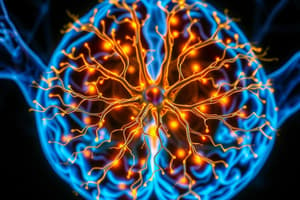Podcast
Questions and Answers
What did the idea of missing link originally mean?
What did the idea of missing link originally mean?
- An isolated human species
- A false appearance of human evolution
- A connection between human and other species
- A gap or hole in human evolution (correct)
Why was the concept of missing link easy to believe?
Why was the concept of missing link easy to believe?
- Because of the isolation of the human species
- Because humans look different from other species (correct)
- Because it was supported by fossil evidence
- Because of the false appearance of human evolution
What did Darwin and his predecessors lack in terms of fossil evidence?
What did Darwin and his predecessors lack in terms of fossil evidence?
- Fossil evidence connecting humans to other species
- Fossil evidence of human origins (correct)
- Fossil evidence of isolated human species
- Fossil evidence of pre-human ancestors
What was the main argument against the idea of missing link?
What was the main argument against the idea of missing link?
What did the human species seem to be, based on the text?
What did the human species seem to be, based on the text?
What does the text state about the idea of missing link?
What does the text state about the idea of missing link?
Which physical adaptation is observed in people from high altitudes in the Andes?
Which physical adaptation is observed in people from high altitudes in the Andes?
What is a likely reason for natives of the tropics to be smaller in stature?
What is a likely reason for natives of the tropics to be smaller in stature?
What did Darwin argue about human races?
What did Darwin argue about human races?
What is a notable characteristic of the early human migrations out of Africa?
What is a notable characteristic of the early human migrations out of Africa?
What is a significant observation about the fossil record related to human evolution?
What is a significant observation about the fossil record related to human evolution?
According to the information provided, which great ape split off first in the lineage of great apes?
According to the information provided, which great ape split off first in the lineage of great apes?
What did Darwin use as evidence of evolutionary history?
What did Darwin use as evidence of evolutionary history?
What did the discovery of Neanderthal fossils reveal about them?
What did the discovery of Neanderthal fossils reveal about them?
What was the significance of the Java Man discovery?
What was the significance of the Java Man discovery?
What did Ernst Haeckel's Paleontological Tree of Vertebrates portray?
What did Ernst Haeckel's Paleontological Tree of Vertebrates portray?
What did Darwin's theory emphasize in relation to common ancestry?
What did Darwin's theory emphasize in relation to common ancestry?
What was the uncertainty surrounding the cause of Neanderthal extinction and the arrival of Homo sapiens?
What was the uncertainty surrounding the cause of Neanderthal extinction and the arrival of Homo sapiens?
What is the Aquatic Ape Theory primarily based on?
What is the Aquatic Ape Theory primarily based on?
What is the correlation between brain size and group size in humans?
What is the correlation between brain size and group size in humans?
Which species coexisted with modern humans and Neanderthals?
Which species coexisted with modern humans and Neanderthals?
What does the fossil record provide extensive evidence of?
What does the fossil record provide extensive evidence of?
What is unique about upright walking according to the text?
What is unique about upright walking according to the text?
Where did human evolution primarily occur according to the text?
Where did human evolution primarily occur according to the text?
Which fossil discovery was a hoax involving a modern human skull and a baboon jaw?
Which fossil discovery was a hoax involving a modern human skull and a baboon jaw?
Which fossil discovery provided evidence of Australopithecus afarensis' walking style?
Which fossil discovery provided evidence of Australopithecus afarensis' walking style?
Which theory of bipedalism has been criticized for citing the loss of body hair and instinctive underwater behavior in infants as supporting evidence?
Which theory of bipedalism has been criticized for citing the loss of body hair and instinctive underwater behavior in infants as supporting evidence?
Which fossil discovery was an Australopithecus afarensis with a small brain and similarities to humans and chimpanzees?
Which fossil discovery was an Australopithecus afarensis with a small brain and similarities to humans and chimpanzees?
Which theory suggests that bipedalism may have been a result of the loss of forests in Africa?
Which theory suggests that bipedalism may have been a result of the loss of forests in Africa?
Which fossil discovery was a Homo erectus with an upright spine, supporting the theory of widespread distribution of this species in Asia?
Which fossil discovery was a Homo erectus with an upright spine, supporting the theory of widespread distribution of this species in Asia?
Flashcards are hidden until you start studying
Study Notes
Aquatic Ape Theory and Human Evolution
- The Aquatic Ape Theory posits that apes adapted to an aquatic environment, but evidence for this habitat is lacking.
- Around 6 million years ago, climate changes and flooding in Africa led apes to adapt to new habitats, such as wading and walking upright.
- The theory suggests that wading in water may have influenced anatomical changes and led to an upright existence in early ape men.
- The video shows a chimpanzee walking on two legs in water in Africa, supporting the theory.
- Brain size is correlated with group size, with humans having similar brain sizes to their social group of 150, possibly leading to the evolution of language.
- Monkeys that formed large ground-dwelling groups in Ethiopia developed complex and communicative societies.
- Recent hominin discoveries include Homo floresiensis and Denisovans, who coexisted with modern humans and Neanderthals.
- The fossil record now provides extensive evidence of human evolution, replacing the old idea of humans ascending from Neanderthals.
- Homo erectus, Java Man, and Peking Man were among the species similar to humans that coexisted.
- Human beings seem isolated due to the extinction of other upright walking ape species, making upright walking unique.
- Early human ancestors made identical objects for thousands of years, but their material culture evolved over time.
- Human evolution occurred in Africa, and human "races" are not biological but result from individual differences and intermixing.
Early Human Fossils and Theories on Bipedalism
- Piltdown Man, discovered in 1912, was a hoax with a modern human skull and a baboon jaw, causing confusion about human evolution.
- Peking Man, found in Beijing between 1923-1937, was a Homo erectus with an upright spine, supporting the theory of widespread distribution of this species in Asia.
- Taung Child, discovered in South Africa in 1924, was an Australopithecus africanus, not a human species, and had an ape-like skull, possibly walked upright.
- Homo habilis, found in 1960 in Tanzania, was a "handy-man" with an ape-like appearance but capable of walking upright.
- "Lucy," an Australopithecus afarensis found in Ethiopia in 1973, was a small female with a small brain, walked upright, and had similarities to both humans and chimpanzees.
- Laetoli footprints, dating back 3.6 million years, were made by Australopithecus afarensis, providing evidence of their walking style, similar to modern humans.
- The reasons for early hominids walking on two legs have not been definitively answered, with theories including the need to see farther over savannahs and to free up hands for activities.
- Bipedalism may have been a result of the loss of forests in Africa, pushing early hominids to adapt to grasslands and savannahs.
- The "aquatic ape theory," suggesting a phase of evolution involving extensive water activity, has been criticized, citing the loss of body hair and instinctive underwater behavior in infants as supporting evidence.
- The debate around bipedalism theories includes the idea of orangutans adapting to an upright stance in trees, which may have then continued on the ground.
- Walking on two legs could have provided advantages in spotting predators and prey, and in efficient long-distance running, but the definitive reason for the shift remains unclear.
- The text emphasizes that while bipedalism is not rare, the specific reasons for early ape creatures to walk upright and the timing of this change are still open to interpretation.
Studying That Suits You
Use AI to generate personalized quizzes and flashcards to suit your learning preferences.




